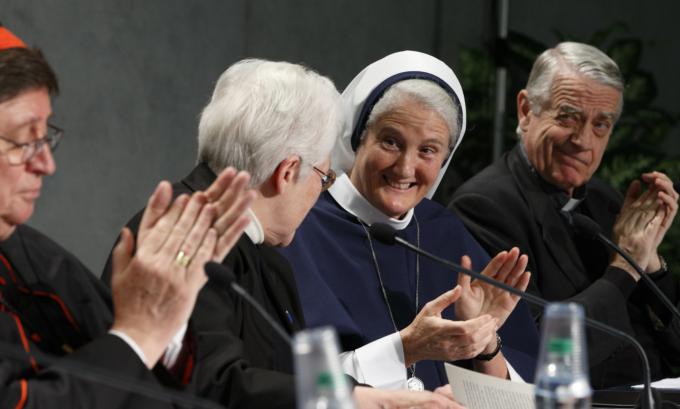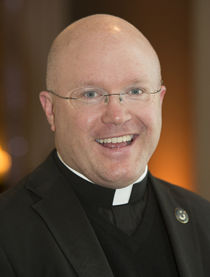
Faith
Last month in a 60 Minutes interview Cardinal Sean O'Malley called the way that the Visitation was announced and received a "disaster" -- and that might have been stating it charitably.

Landry
This month, the Vatican's Congregation for Institutes of Consecrated Life and Societies of Apostolic Life (CICLSAL) released its report of the Apostolic Visitation of non-cloistered women's religious communities in the United States. It was written with a positive Christmas spirit, effusively praising women religious for all they've done for the Church's "evangelizing mission, selflessly tending to the spiritual, moral, educational, physical and social needs of countless individuals, especially the poor and marginalized" while diplomatically phrasing its concerns.
The religious women involved, secular and Catholic media professionals, and all other interested observers noticed an enormous change in tone between the launching of the Visitation six years ago and its concluding report. Last month in a 60 Minutes interview Cardinal Sean O'Malley called the way that the Visitation was announced and received a "disaster" -- and that might have been stating it charitably.
There was initially no elementary communications component to the Visitation so that women religious and everyone else would see why the Vatican was commissioning it in the first place, how many sisters themselves from communities that had lost their Catholic moorings had requested the Vatican's help, how Visitations are routine in religious life, what its scope and tenor were envisioned to be (more a "sister-to-sister" dialogical self-assessment than an antagonistic examination), what specific behaviors the Congregation was concerned about, and how it was intended to help revitalize women's religious life.
Instead the Visitation was portrayed as a general Inquisition by crepuscular, authoritarian chauvinists in Rome punitively bullying holy sisters for minor concerns in order to take the focus off the big scandals for which these ignorant misogynists were responsible and toward which rather they should have been devoting their attention all along.
The Catholic faithful -- especially those taught by sisters in Catholic schools, cared for by them in Catholic hospitals, and served by them in various ministries --rose up reflexively in the defense of their spiritual mothers, incredulous that the heroines they knew could ever be the subject of a hostile inquest even from anti-Catholic bureaucrats in Communist or secularist governments, not to mention the hierarchy of the Church.
If faithful had known what was really going in several women's religious institutes in the United States --if they had known what the problems were that precipitated the Visitation -- their reaction would surely have been different.
Catholics would find hard to believe that there are various sisters who, with the support of their communities, protest in favor of abortion; that there are communities that no longer regularly celebrate the Eucharist because they refuse to have Mass celebrated by a man; that various sisters in leadership positions openly question the doctrine of the Holy Trinity, the divinity of Christ and the inspiration of Sacred Scripture, not to mention the Church's teaching on Holy Orders and the immorality of same-sex activity, abortion and euthanasia; that various communities have ceased promoting new vocations altogether; and that, in the words of Sr. Laurie Brink, the former President of the Leadership Council of Women Religious (LCWR), the largest association of women religious in the United States, some sisters had moved "beyond the Church, even beyond Jesus."
I was recently told by a bishop in the Midwest that he had just celebrated a Mass for three sisters who were marking their 75th anniversary of religious life. When the younger sisters in the community asked them what they wanted to do to celebrate, they replied, "We'd like to have Mass." The younger sisters -- meaning those in their 60s and 70s -- replied, "We don't think that's a good idea." The jubiliarians responded, "We thought that's what you'd say, so we already asked the Bishop and he's accepted to come." The bishop told me that the three nonagenarian jubilarians were seated in their habits in the front row of the chapel smiling throughout the anniversary Mass, whereas most of the other members of the community were sitting sullenly without habits many rows behind.
This episode shows what has happened in various women's religious communities in the United States and why various sisters, like the jubilarians, had asked the Vatican to intervene: their communities had lost their path and many of their superiors had ceased to lead them in the footsteps of Jesus. They had stopped in some noteworthy ways living the Catholic faith and their proper charisms, which the Church and the faithful both legitimately expect. So many sisters from various communities had written about such issues that CICLSAL decided on a general visitation rather than many individual ones.
The positive tone of the Visitation Report shouldn't be interpreted as an indication that the Vatican has given an overall bill of clean health to women's religious life in the United States. There is much that's good and healthy, but there is also a lot that's necrotic -- and those who love women religious and who love the Church they serve must not be afraid to state and confront the obvious issues.
The report noted that only 78 percent of women's religious institutes in the United States participated at all in the Visitation. 22 percent refused outright and many others only partially participated. A large percentage of communities totally spurned CICLSAL's authority, a lack of cooperation that its leader, Cardinal Joao Braz de Aviz, called a "painful disappointment."
The report observed that the number of women religious in the United States has fallen from 181,000 in 1965 to 50,000 today and that the median age is mid-to-late 70s, putting the care of elderly sisters and the survival of many communities at risk.
The report declared that young candidates "often desire the experience of living in formative communities and many wish to be externally recognizable as consecrated women. This is a particular challenge in institutes whose current lifestyle does not emphasize these aspects of religious life." This is a tactful way of saying that many older religious don't wear habits distinctive of their consecrated identity and don't live in community but in apartments on their own, a worrisome trend contrary to the community life that is central to Christian, not to mention religious, life.
The report mentioned that institutes generally have "written guidelines for the reception of the sacraments and sound spiritual practices" but asked "each institute to evaluate its actual practice of liturgical and common prayer." The translation is that many communities aren't following their own guidelines regarding prayer and providing sisters access to Mass and Confession.
The report called upon "all religious institutes carefully to review their spiritual practices and ministry to assure that these are in harmony with Catholic teaching about God, creation, the Incarnation and the Redemption" and "not to displace Christ from the center of creation and of our faith." In other words, various communities' practices are neither centered on Christ, nor even in basic alignment with Church doctrine on Christ as the Creator, Emmanuel and Savior.
At the press conference announcing the final report, Mother Agnes Mary Donovan, Superior General of the Sisters of Life and Chairperson of the Council of Major Superiors of Women Religious (CMSWR) -- a smaller association of 125 women's religious communities in the United States -- injected an important note of hope.
She described that the average age of sisters in CMSWR communities is 53 and that twenty percent of CMSWR sisters are still in initial formation. She noted that research shows that many young women are still hearing the call to religious life but that they're looking for communities that feature prayer and the sacraments, vibrant community life, and external signs of their consecration -- like identifiable religious habits -- that provide needed, conspicuous public witness in an increasingly secularized world.
That young women have not been able to find those spiritual and vocational staples in many institutes of religious women in the United States is one of the reasons why the Visitation was necessary.
The Report stated that the Year for Consecrated Life just begun is an opportunity not only for all consecrated women to renew their vocations according to their founding charisms and the mind and heart of the Church.
It's also a summons for all the faithful to pray and express our appreciation and gratitude for those women who have heard to God's call -- most of whom continue to give their lives heroically and faithfully in service of him and others, and some of whom are in need of special prayers, help and guidance to realign themselves with the Church in order to experience the revitalization of their religious life that this Year for Consecrated Life and the Apostolic Visitation are both intended to foster.
- Father Roger J. Landry is a priest of the Diocese of Fall River, Massachusetts, who works for the Holy See’s Permanent Observer Mission to the United Nations.
Recent articles in the Faith & Family section
-
Scripture Reflection for April 21, 2024, Fourth Sunday of EasterJem Sullivan
-
The new Temple: How Easter changes religionDr. R. Jared Staudt
-
The wonder of Ordinary TimeLucia A. Silecchia
-
Is there still responsibility for past sins after confession?Jenna Marie Cooper
-
Wounds, not scarsJaymie Stuart Wolfe


















